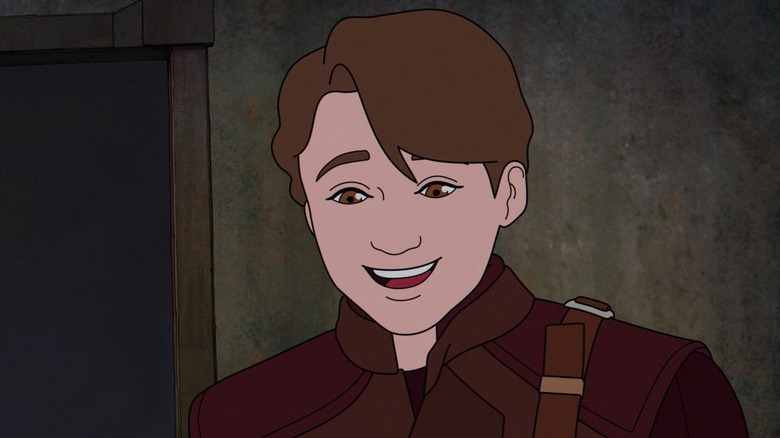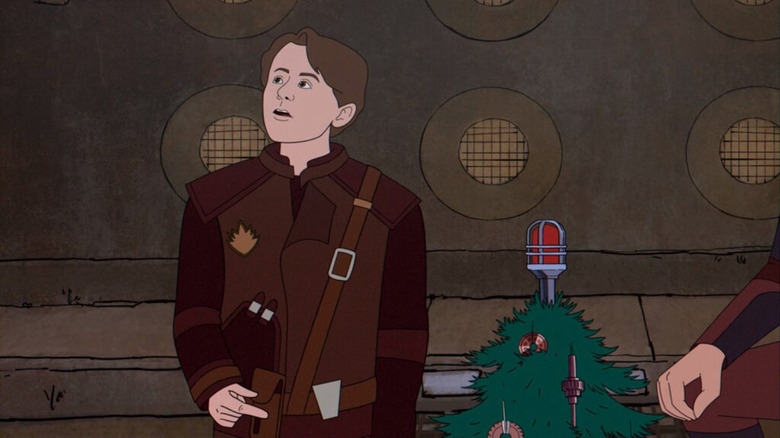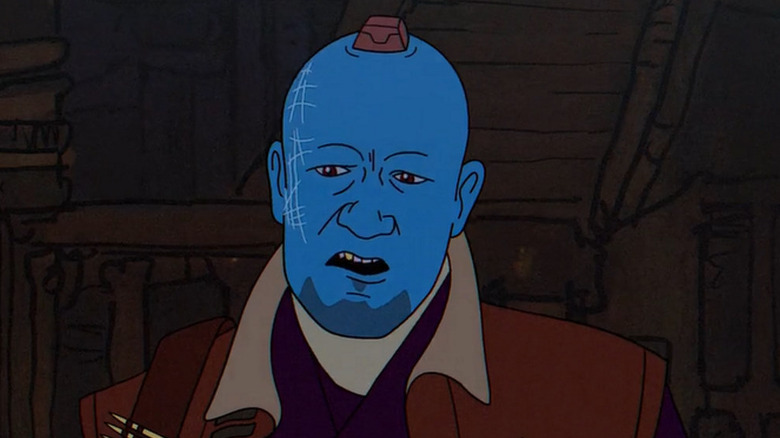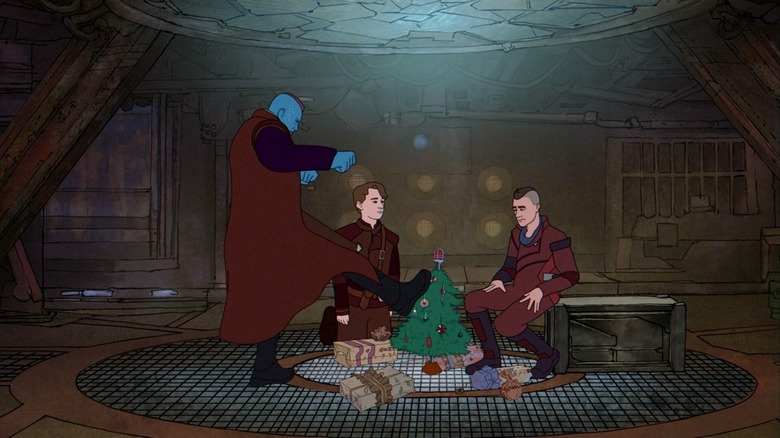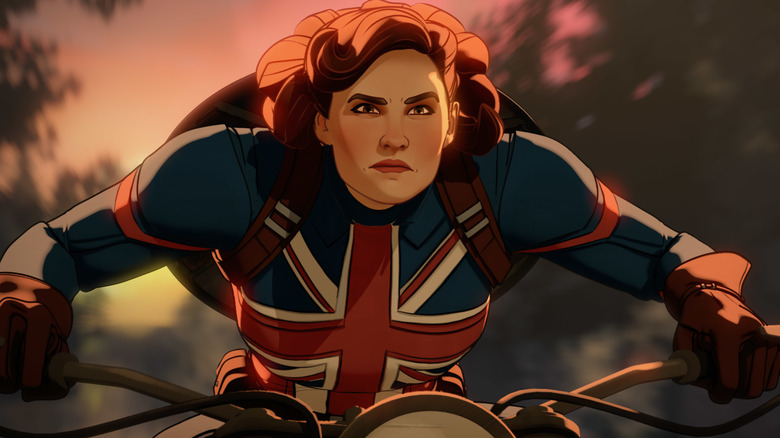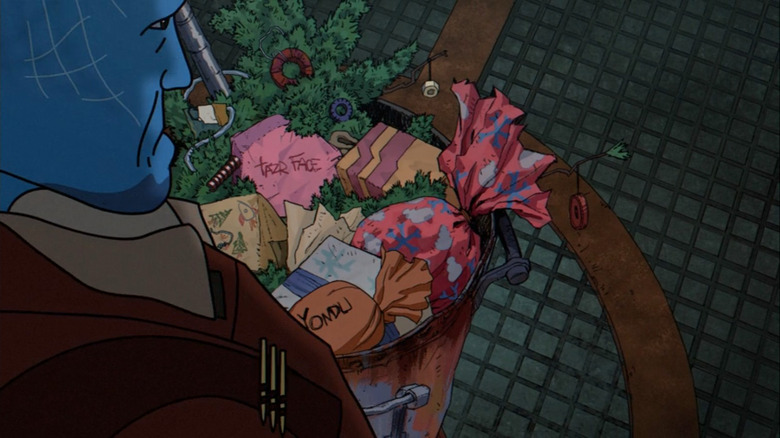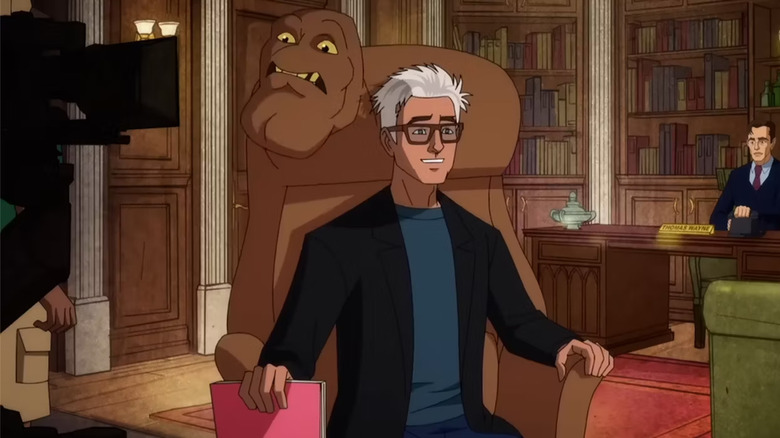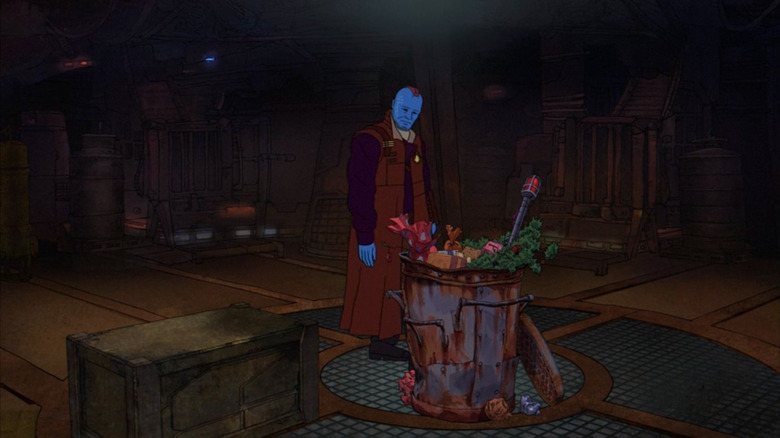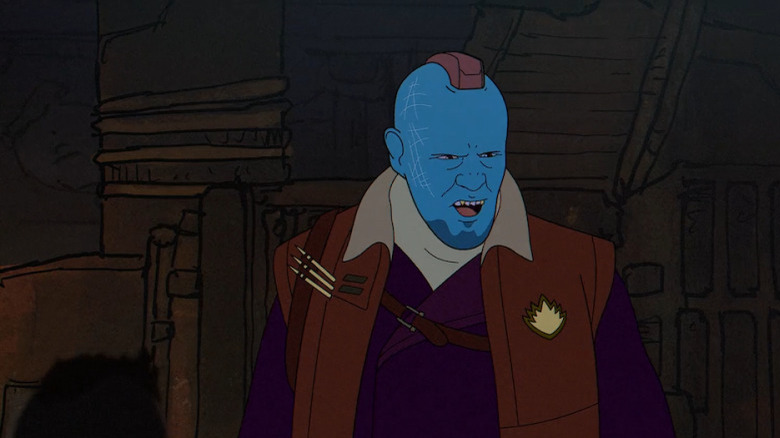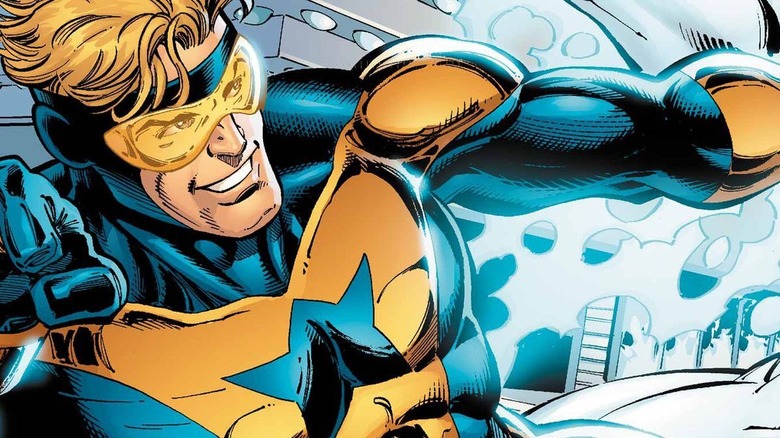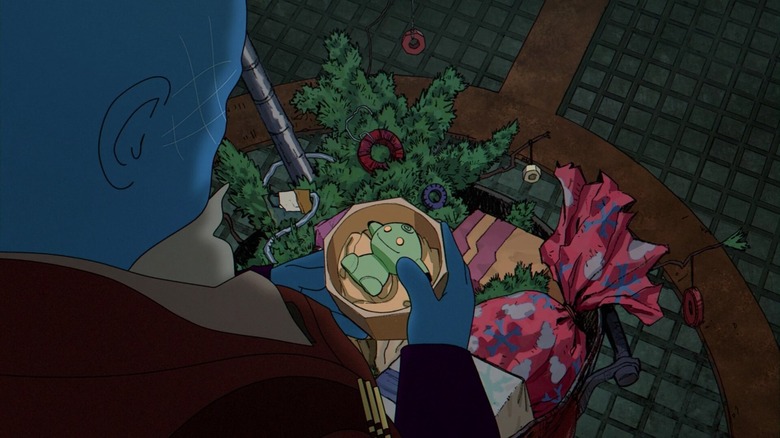The Animators Behind The Guardians Of The Galaxy Holiday Special Knew They Were Making Magic [Exclusive Interview]
"The Guardians of the Galaxy Holiday Special" is a lovely little bit of holiday cheer, following Mantis (Pom Klementieff) and Drax (Dave Bautista) as they try to find and retrieve the perfect Christmas present for their friend Peter Quill (Chris Pratt). The light-hearted, fluffy special comes from the mind of James Gunn, who also wrote and directed the "Guardians" films, and it serves as a nice epilogue to Phase 4 of the Marvel Cinematic Universe. The special is mostly live-action, but some quick flashbacks from Peter's first Christmas with the Ravagers appear, and they're animated. Gunn wanted to use animation to riff on the animated segments in "The Star Wars Holiday Special," while also paying homage to the work of animation titan Ralph Bakshi.
The animation for the special was done by Stoopid Buddy Stoodios, best known for their work on "Robot Chicken," though they have been working in 2D and 3D animation and stop-motion of all kinds for decades. At the head of it all was animation director Mac Whiting, who helped bring Gunn's vision of a Bakshi-esque "Guardians of the Galaxy" to life. I had the chance to sit down and chat with Whiting via Zoom; he has also worked on "Harley Quinn," "The Spongebob Movie: Sponge Out of Water," and "Batman: The Long Halloween Part One." He shared the inspirations for his style of rotoscoping, explained what makes rotoscoping different from what we think of as "traditional" animation, and his idea for the next great superhero show.
This interview has been lightly edited for clarity and brevity.
'The animation world is a very small pond'
Can you tell me a little bit about how you got involved with this project, and how Stoopid Buddy Stoodios got involved, and how it all came together?
The animation world is a very small pond of interconnected people knowing each other and stuff like that. I actually had worked with a great producer and director by the name of Tony Cervone, best known for "Scoob!" and working with a lot of great Warner Brothers properties over the years. He and I collaborated on a project a little over a year ago, on a show called "Legends of Tomorrow," in which there was an animated segment of the show that I was the animation supervisor for. He and I hit it off.
I guess he has a relationship with Stoopid Buddy and Duke at the studio. They were reaching out to people, artists, to see who might be a good fit for this. Tony actually recommended me, and reached out to me if this was something I would be interested in. I said, "Absolutely."
That was actually my first formal introduction to Stoopid Buddy. I, of course, have been a fan of their work for many years, but this is my first opportunity to work with them directly. Then we launched into the animation test, as it were.
'The initial test, I think, was somewhere close to 300 drawings'
How did you do the animation test? Did you just shoot other people as stand-ins for Rooker and Sean Gunn, or did you actually manage to get ahold of them for your test?
For the test footage itself, Marvel provided a B-roll clip from the original "Guardians" movie. In discussing the scope of the project and the timeline in which we needed to produce the test, I elected to just focus on Rooker and the Yondu character specifically.
The original test was just a one shot of Rooker talking, and then I collaborated with an incredibly talented background artist by the name of Rafael Hurtado. He created just a singular background. We were just trying to create the overall aesthetic and look that I was picturing and picking up on, from the direction from both Stoopid Buddy and Marvel, that we were trying to achieve. That turned out to be about an eight-second piece, just of Rooker talking. Took almost six weeks to complete.
I'm just leading right ahead here, but once I heard that it was intended to be in this Bakshi rotoscope style, not only had I grown up and loved those movies as an animation fan and animator myself, but I found some great archival footage on YouTube and stuff of how they made it, and just wanted to honor that process as much as possible. So it became clear to me there really wasn't any way of cheating this. It had to be straight-ahead, traditionally drawn.
The initial test, I think, was somewhere close to 300 drawings that I did. That was, again, just a chest up dialogue shot. That's why it took so long to produce.
But yeah. I, and I think clearly the rest of the team, was very thrilled with the results. I think Marvel themselves even commented that a lot of the tests that came in, the studios just leaned more into traditional animation, and didn't honor the rotoscope style. That was what set our test apart and earned us the full job.
'It's a little more complicated than I think people necessarily give it credit'
I love that, because the rotoscope style is so immediately recognizable. There's something about, I'm not sure if it's animating on threes instead of fours, or if there's some sort of trick to it, but it just looks different. Could you tell me a little bit about rotoscope versus what we think of today as just standard animation?
Yeah, absolutely. When you're trying to trace back or artistically interpret live-action footage, the frames come in, or there's literally a frame for every single microsecond. 24 frames make up a second. There's a frame for every one of those 24 frames. In live-action, things are moving on a granular level.
So I think the real artistry in rotoscope is determining how few drawings you can do to make something look fluid and natural, without it catching your eye as looking jittery or stuttery. It's a fine art to that trial and error experimenting process.
Most of the stuff we did was on twos. We stretched a few things out to threes, and very little on fours. But I think when it gets out to fours, you start to notice, as I said, that stuttery feel. Then it's like, "Maybe we need one more in between in there," so we would add maybe one or two more drawings.
It's a little more complicated than I think people necessarily give it credit. There's something to be said about just tracing over an image or live-action footage, but honing in on the details and finding a caricature almost of the live-action person that is still resembling them, but also has a hand-drawn feel, is tricky. Anyone could take a stab at it, but if you give it to five different artists, it could be interpreted very differently.
I think that was also part of the test, and why it took me a little longer, was that trial and error process of how many drawings can I get away with and cheat this, and how many do I just have to straight-up draw and redraw every time, while also having enough details that you can recognize the character in the movement, but not so many that you're like, "Oh my gosh. I have to redraw his bandolier a thousand times." There's so many intricate details in these costumes and these characters that it's tricky. You can get sucked into that pitfall.
'I did watch the 'What If...?' series'
I was actually going to ask you about that. How do you decide which details are going to make the cut, and which ones are just too much to try and animate, or are just going to get lost anyway?
The first thing I did, before I even started the animation, was I wanted to pull as much reference material as I could. That was actually re-watching the movies, which was a pleasure, of course, [and] doing extensive Google searches. Marvel was great in terms of offering some resources. We got some costume fitting pictures and things like that, which were really helpful. I did watch the "What If...?" series as well. I wanted to see their artistic take on it.
I did a few designs. I did some roughs that I didn't really share with anybody, and then tried to pare it down and find, like I said, enough details where the costume looked cool, but not so many that we would be burdened to draw it over and over and over again.
Then just when it started feeling good, and I thought it was looking in the ballpark, submitted them. Fortunately, everyone was really happy and cool with the way it was looking and going. So we just dove in.
'It was only about 10 or 12 people in total'
Gunn has posted a little bit of behind the scenes stuff of actually shooting for the rotoscope with Rooker on set. He doesn't have to be blue, which is great. I was wondering if you could tell me a bit more about the actual production?
This was a pretty tight production in terms of our turnaround time. It was really cool. When they liked the test, and we started talking about the actual production of the featurette, it became clear, and we were huge advocates for shooting a practical set or shooting the sequence, because a couple of the trickier parts creatively were, number one, it is a flashback. So we knew that we were going to have to de-age Sean Gunn's Kraglin character. Furthermore, the actor who played young Peter is now a teenager or young 20-year-old kid. So they had another wonderfully talented young actor stand in for him for the shoot, but we did want to pay homage to the original actor.
The two things that were tricky were capturing the performance, we knew this going in, and then having to create an artistic representation of them, but looking like younger versions of themselves, if that makes sense. Marvel very graciously set up a shoot in Georgia on one of their big lots where they were filming "Guardians 3." So we got to go into a big warehouse sound stage. They had pre-taped-off the sets where people would sit and that kind of stuff. But we had very minimal props. The prop department was there. But it was almost like shooting on a green screen, in a way.
It was really cool. It was very collaborative. We got to work and sit with James directly, and talk about the direction of the camera and things of that nature, making sure that it was simple enough for animation, but also dynamic enough so it had that big cinematic feel.
We got the shoot. They edited and provided us the footage. Then we launched, pretty immediately thereafter, with a lean team of animators. We did collaborate with a studio, Studio Moshi in Australia, because another thing that became evident from the test was that I certainly was not going to be able to animate this thing single-handedly.
We had an incredible team there, but all in all, it was still small. It was only about 10 or 12 people in total, working pretty tirelessly around the clock. I think it was approximately four months. But yeah. We went ahead, and we divided up the scenes accordingly. We tried to cast them based on different artist strengths and weaknesses.
Again, coming back to now we're rotoscoping, but we're also drawing to designs, as opposed to the live-action footage, in a sense. Because Kraglin, I had to design him as a younger version of Sean Gunn, which had a little bit of back and forth, but again, Marvel was great in terms of their feedback, and very supportive of that.
Then I had to find a lot of stock footage and imagery of the actor who played young Peter, and so we were drawing over this actor's performance, but then trying to make it look like the original actor. That was interesting.
'Even meeting James Gunn was a bucket list thrill moment for me'
You definitely had your work cut out for you.
Yes, indeed.
This is not the first time you've worked with James Gunn. He's also in "Harley Quinn," in season 3. You've done a ton of work with DC. You've done a bunch of work with Disney now. What's it like working with these giant studios, compared to animating something more independently?
Sure. Yeah. I feel very fortunate. I have grown up in this business since the beginning of the 2000s. My first job out of school was at Nickelodeon. I was still working on paper. I was doing board revisions and designs on paper, and with pencil and stuff. So I bridged that gap of traditional animation right as the internet — it's crazy to say now, but the internet was taking off, and things like Flash animation was starting to ramp up. So I had just enough exposure in the traditional field to then transition into the digital one, right at the cusp of that.
I was very fortunate to, yes, start working at some bigger studios, but I also did a lot of work with independent studios. There was a big influx of need for content and young creatives in Los Angeles in particular that were banding together to make things for the web. So I got to cut my chops with a lot of web cartoons and things of that nature.
It was great, because I think just providing that sort of baseline foundation of skillset helped build my confidence and experience up to now, working with these bigger studios, as you said. It can be intimidating, for sure, at first, but I think, as I've done this for a long time now, and as you get to meet people and know people around the industry, more often than not, everyone values the experience and the creative voice. There are a lot more similarities than differences, quite frankly.
Even meeting James Gunn was a bucket list thrill moment for me. I didn't know what to expect. He could not have been more collaborative and gracious, and just aligned creatively. So it was absolutely hugely fulfilling for me personally, just as a fan of his and stuff. But then when you start to talk about these things, you realize we're all just big nerds that love superhero stuff. We love cartoons.
At the end of the day, if you have an idea that someone is like, "That looks cool. I love it. Let's do that" ... I would definitely encourage younger artists to not be afraid to speak up if they have an idea or something to put out there, because you never know. The worst thing that can happen is being told no or, "That's not going to work."
I was also, in a weird way, blessed with ... I've worked on a ton of projects that have never seen the light of day. You learn to really ... these types of wins, like this "Guardians" special, which was so incredible, you don't take for granted.
Because I've literally worked on projects that are complete and in the can. You're like, "Okay. That's supposed to air on Wednesday," and then the show gets canceled or something. It's like, "Well, what can I take away from that experience?" I learned a lot. I worked with some great people. So any time something actually gets out there in the public eye, especially something of this nature, it's just hugely fulfilling and gratifying.
'They're really just tools for storytelling'
In that same vein, I think it's interesting that animation is starting to be taken a little bit more seriously. Finally, it starts to feel like that. I know Alberto Mielgo at the Oscars last year was talking about how animation matters, and these aren't just kids' stories. I was wondering what your take on the future of animation is, because it feels like we're moving towards doing a little more animation and being more experimental.
I certainly hope so. I think the inclusion at the Oscars, the higher profile stuff is luring people in. You see incredible directors like Guillermo del Toro getting into stop-motion and experimenting. He's always been on the cusp of experimenting and stuff like that.
At the end of the day, I think storytelling, in general, is always looking for fresh ideas and takes on how to make it unique and intriguing. Animation is certainly something that lends itself to that. This homage to Bakshi is a prime example. That stuff was really starting back in the '20s and then through the '50s and '60s. It's an art form, at the end of the day.
I think that, certainly with James coming to Warner Brothers, and talking about integrating DC and wanting to do more animated stuff, I think people are taking it a little more seriously or are more interested. The range of things, everywhere from preschool to adult animation, there's clearly an appetite for it. I hope it continues.
I think what's most interesting to me, frankly, is the integration of the new technologies. We obviously have seen what CG can do, and the face swapping and all that sort of stuff. But I'm especially interested in what we can do in 2D animation or 3D, other aspects in that regard, if we will start to incorporate it a little more to do some of the grunt work.
But to me, at the end of the day, all this stuff, they're really just tools for storytelling. I think animation provides people this limitless window of opportunity, because you can literally create anything from thin air, go anywhere. Sky's the limit, based on each artist's imagination and stuff. So yeah. I'm very happy to be doing what I'm doing.
'The Bakshi style was definitely at the forefront'
With regards to the "Guardians" special, I was wondering ... obviously there's Bakshi, but what other artists or films or things like that did you tell the animators to reference? Were there any other big influences on the style?
The Bakshi style was definitely at the forefront, because that was something that James himself mentioned. From what I've read and seen, fans clearly understood that. They got it. Even if they didn't fully understand the exact film or history, it gave that impression, which was wonderful. So I would say that was really the primary one.
I loved the animated "Lord of the Rings" growing up, it was incredible. I think that something I watched a lot of was the "Fire and Ice" movie. Ironically, I think what we ended on was a little bit more of the "American Pop" or maybe even "Heavy Metal" versions of Bakshi, because, well, for one thing, we didn't have Frank Frazetta designing everything. But that was definitely the forefront. We really tried to focus in on that and give it that stylistic feel.
As I said, we did everything digitally. We did add a little bit of a grain in there and stuff, just to push that old-timey feel and nostalgic feel to it, but it's a little subtle.
But yeah, all in all, just the classic Disney animation stuff was a little bit on the peripheral, but for the most part, it was purely Bakshi stuff for this particular situation.
'I think would be really funny to do a fresh take on ... Booster Gold'
What would be your dream project? If you could get any animation project off the ground anywhere, what would you want to do? Just put it out there.
Oh boy. Wow. That's a really great question. Man. This was close to the top of list. I'll just say that. It's tough to top this one. It's had a lot of things that I'm a huge fan of and loved putting together.
I think there's some untapped characters in both universes. I think it would be really fun to do an obscure DC or a Disney character, and do a similar origin story.
I think one character that's really pertinent to today's day and age, and I think would be really funny to do a fresh take on, is Booster Gold, as a matter of fact, from DC. I don't know why I was attracted to that character as a kid. I loved those comics for some reason, because the guy's really not a lovable character, frankly.
I envision him like a modern day Jake Paul. It was like a poser. I could just see him being all about the Instagram feeds and all that stuff, with his little robot, and being this big poser. But I think there's something charming about that, having some sort of a redeeming arc, where that gets stripped away from him, and he has to be a hero instead of a poser. I think that's intriguing.
I've had a chance to work on Batman, and done a little development work with Bruce Timm on the new Batman series. Then there's the Disney stuff ... I have little kids at home, so we're watching Disney+ 24 hours a day over here. I feel like I'm living the dream, frankly.
'Animation is a lot of hard work, but it's a labor of love'
Is there anything you want the readers at /Film to know about the special, or about animation, or just about what you've got going on?
First and foremost, I just hope everybody enjoys it. I think it's a pretty lighthearted romp. Life has been stressful enough the last few years that sometimes it's fun to just check out and not take things so seriously. So I hope everyone can appreciate this was made with love and care. At the end of the day, it was just intended to be for fun.
Animation is a lot of hard work, but it's a labor of love. I would definitely encourage anybody who's interested to keep pushing. There's a lot of great programs out there in the world. As you said, I think it's becoming more prominent in society and more accepted.
When I went to high school, I didn't even know you could do this. I just wanted to be an illustrator. It wasn't until I got into college, and exposed to more people and cinema, that I realized this was a path I could pursue.
I think it's become a lot more commonplace, which is wonderful. I think the more artists and voices and people who are out there doing it, the broader and more interesting the stuff can become. Especially in this day and age, I encourage people to go out there if they're inspired by this in any way, shape, or form. My personal information is out there for the finding. Definitely reach out. I am a busy person, but I certainly try to make the time to get back to people when I can. I hope everyone is happy and healthy. I think this is a really perfect and topical short for the holidays.
"The Guardians of the Galaxy Holiday Special" is currently streaming on Disney+.
